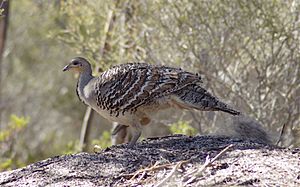Yumbarra Conservation Park facts for kids
Quick facts for kids Yumbarra Conservation ParkSouth Australia |
|
|---|---|
|
IUCN Category VI (Managed Resource Protected Area)
|
|

Malleefowl
|
|
| Nearest town or city | Ceduna |
| Established | 30 May 1968 |
| Area | 3,243.52 km2 (1,252.3 sq mi) |
| Managing authorities | Department for Environment and Water Far West Coast Aboriginal Corporation |
| Website | Yumbarra Conservation Park |
| See also | Protected areas of South Australia |
Yumbarra Conservation Park is a special protected area in South Australia. It's about 55 kilometers (34 miles) north of a town called Ceduna. This park was created to protect its unique plants and animals.
The park shares its borders with other important natural areas. To the north, it meets the Yellabinna Regional Reserve. To the east, you'll find the Pureba Conservation Park.
Contents
What is Yumbarra Conservation Park?
Yumbarra Conservation Park is a large area of land that is kept safe for nature. It was first called Yumbarra National Park, but its name changed. The park helps protect many different types of plants and animals.
Why is the name "Yumbarra" special?
The name 'Yumbarra' comes from a cool rock hole in the area. When it rains, this rock hole fills up with water. It becomes a temporary watering spot for all the animals in the park. This makes it a very important place, especially for birds, so it's great for bird watching!
Animals of Yumbarra Conservation Park
Yumbarra Conservation Park is home to many interesting animals. Some of them are very rare and need our help to survive.
- Dingoes: The park is located outside the Dingo Fence, which is a long fence built to keep dingoes away from farms. This means dingoes are allowed to live freely here.
- Malleefowl: These are special birds that build large nests on the ground. They are an endangered species, meaning there are not many left.
- Sandhill Dunnarts: These are tiny, mouse-like animals that are also endangered. They live in the sandy areas of the park.
- Wombats: You might see southern hairy-nosed wombats, which are strong, burrowing animals.
- Kangaroos: Like many parts of Australia, the park is also home to kangaroos.
Exploring the Park's Landscape
The land in Yumbarra Conservation Park is mostly dry, with lots of rolling sand dunes. It's a beautiful example of an arid (dry) landscape.
Googs Track: An Adventure Road
A famous road called the Googs Track runs through the park. It's about 120 kilometers (75 miles) long and is only for four-wheel drive vehicles. This track heads north towards the Yellabinna Regional Reserve and a place called Googs Lake. There are also a few walking trails that follow parts of the Googs Track.
Protecting Yumbarra's Future
Yumbarra Conservation Park is a very important place for Australia's wildlife. It helps protect some of the most endangered species, like the malleefowl and sandhill dunnart.
Working Together for Conservation
In 2013, a special agreement was made to help manage the park. The Far West Coast Aboriginal Corporation and the Government of South Australia agreed to work together. This means the Aboriginal Corporation helps give advice on how to best look after the park and other protected areas in the western part of the state. This partnership helps make sure the park is managed in a way that respects both nature and traditional knowledge.
Images for kids
-
Prostanthera ammophila (mintbush) within Yumbarra Conservation Park




